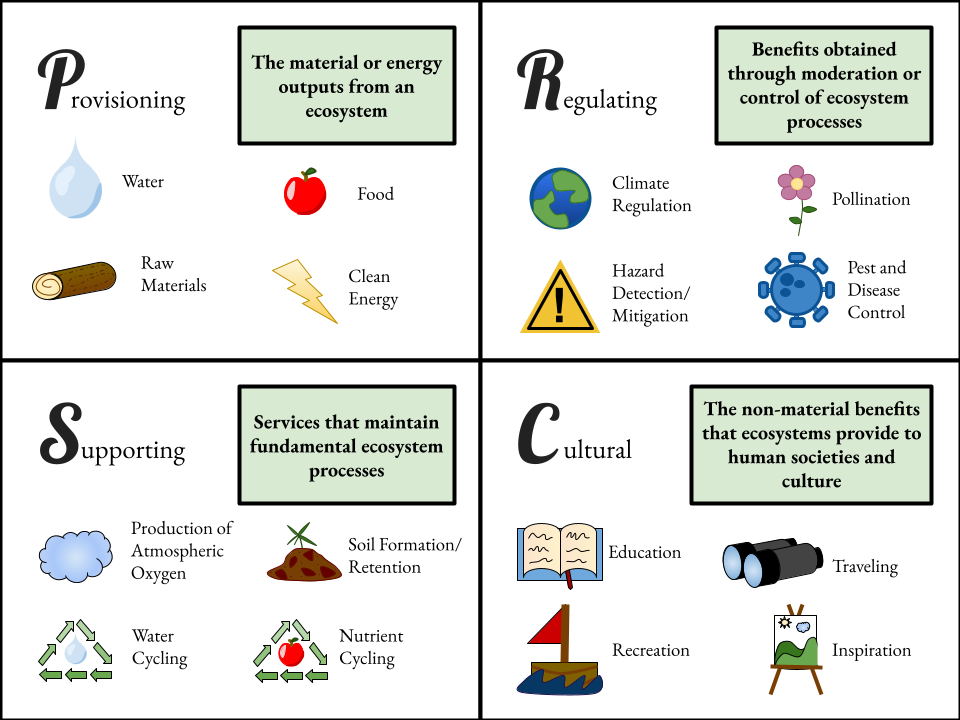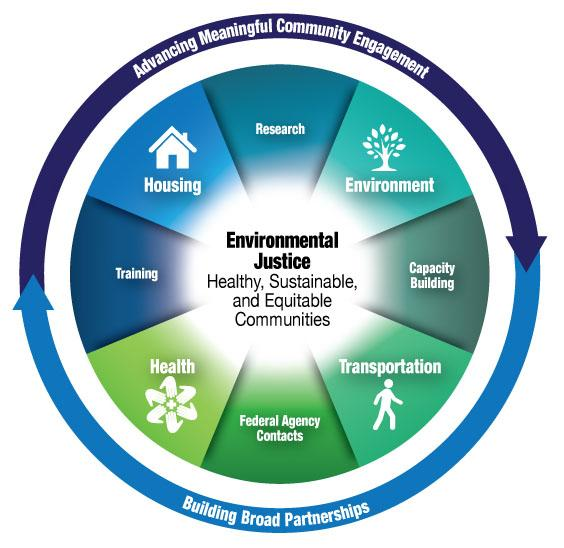IB Syllabus focus:
‘Conservation choices reflect aesthetic, ecological, economic, ethical and social arguments and differing worldviews; success needs community support, funding, education, legislation, and science, with attention to environmental justice.’
Conservation decisions arise from multiple values and perspectives, each shaping priorities and approaches. Understanding these justifications is essential for effective biodiversity protection and long-term sustainability.
Values in Conservation
Aesthetic Values
Many conservation arguments highlight the beauty and inspiration derived from natural landscapes and wildlife. People value biodiversity for the sense of wonder, recreation, and cultural identity it provides. Scenic places, charismatic species, and iconic ecosystems are often prioritised because they resonate with human appreciation for nature’s beauty.
Ecological Values
Biodiversity underpins ecosystem services, which are the benefits people gain from functioning ecosystems.

Four core categories of ecosystem services—provisioning, regulating, supporting and cultural—illustrated with concise examples. This aligns with how biodiversity generates material and non-material benefits that justify conservation. The simple layout aids quick recall for comparisons across sites. Source.
These include:
Provisioning services: food, timber, and freshwater.
Regulating services: climate regulation, flood control, and disease regulation.
Supporting services: nutrient cycling and pollination.
Cultural services: spiritual, recreational, and educational benefits.
Ecosystem services: The direct and indirect benefits people derive from natural ecosystems, ranging from material goods to life-supporting processes.
Economic Values
Biodiversity has monetary worth through natural resources, tourism, and ecosystem services. For example:
Fisheries and forestry provide livelihoods.
Ecotourism generates income in protected areas.
Genetic resources support agriculture and medicine.
A healthy ecosystem reduces the need for expensive artificial substitutes. Conversely, biodiversity loss imposes costs through reduced productivity, disaster vulnerability, and healthcare burdens.
Ethical Values
Ethical arguments emphasise that all species have intrinsic value, regardless of human use. This perspective supports conservation based on moral responsibility to protect life forms and future generations. Ethical reasoning also involves:
Animal rights: ensuring welfare of individual animals.
Intergenerational equity: maintaining biodiversity for future human needs.
Stewardship: humans as guardians of the planet.
Social Values
Communities often depend on local biodiversity for cultural practices, traditions, and survival. Social justifications include:
Respect for indigenous knowledge systems.
Recognition of biodiversity in shaping identity and heritage.
Community-based resource management that strengthens resilience and cohesion.
Perspectives on Conservation
Anthropocentric Worldview
Places humans at the centre, valuing biodiversity primarily for its usefulness. Conservation is justified when it benefits people directly, such as through resource sustainability or economic gain.
Ecocentric Worldview
Sees ecosystems as having value in their own right. Conservation is pursued to maintain ecological balance and integrity, independent of direct human benefits.
Technocentric Worldview
Emphasises the ability of technology and innovation to solve environmental problems. Conservation is framed in terms of scientific management, genetic engineering, or technological restoration.
Worldview: A particular philosophy or perspective through which individuals and societies interpret humanity’s relationship with the environment.
Justifications for Conservation
Scientific Justification
Scientific evidence demonstrates the role of biodiversity in maintaining planetary stability. Data on species interactions, ecological thresholds, and climate resilience provide powerful rationales for conservation action.
Educational Justification
Nature offers learning opportunities, from field studies to public awareness campaigns. Education fosters a conservation ethic and equips future generations to address environmental challenges.
Legislative Justification
Governments enforce laws and treaties to regulate resource use and protect biodiversity. Examples include national park legislation, endangered species acts, and international agreements like CITES.
Financial and Institutional Support
Conservation projects require sustained funding and institutional commitment. NGOs, governments, and international bodies provide resources to manage reserves, monitor biodiversity, and train local communities.
Environmental Justice
Conservation must also address equity and fairness. Environmental justice ensures that benefits and burdens are distributed fairly, particularly for vulnerable or marginalised communities affected by conservation policies. It emphasises:
Inclusion of local voices in decision-making.
Respect for land rights and cultural values.
Avoiding displacement or exploitation in the name of conservation.

Environmental justice links environmental quality to health, housing, transport and livelihoods, highlighting why inclusive participation and fair outcomes matter in conservation. Use this to illustrate justice-centred justifications for protection and regeneration. The diagram includes U.S. programme labels not required by your syllabus. Source.
Enablers of Conservation Success
Community Support
Conservation thrives when local communities are engaged and benefit directly. Projects that exclude or disadvantage local people often face resistance and fail in the long term.
Funding and Resources
Adequate financing allows for staffing, infrastructure, monitoring, and enforcement. Without sustained investment, even well-designed conservation strategies cannot succeed.
Education and Awareness
Public awareness campaigns encourage behavioural change and create a broad conservation ethic. Environmental education in schools fosters long-term commitment.
Science and Research
Monitoring biodiversity, tracking ecological changes, and evaluating conservation outcomes all rely on rigorous science. Evidence-based decisions improve effectiveness and adaptiveness of conservation policies.
Legislation and Governance
Strong legal frameworks provide the authority to restrict harmful practices, establish protected areas, and prosecute environmental crimes. Governance mechanisms ensure compliance and accountability.
FAQ
Aesthetic values often drive public support and donations, as people are more inclined to protect species or landscapes they find visually appealing or culturally iconic.
Flagship species such as pandas or tigers attract significant funding because they inspire public interest. This funding can then extend protection to entire ecosystems, even though the initial motivation was based on aesthetic appeal rather than ecological function.
Intergenerational equity ensures that natural resources and biodiversity are maintained for future human needs and cultural continuity.
This principle means today’s actions should not compromise the ability of future generations to benefit from healthy ecosystems. It provides an ethical foundation for conservation policies that extend beyond immediate economic or political interests.
Indigenous knowledge provides context-specific insights into species behaviour, ecological interactions, and sustainable management practices.
It often emphasises stewardship and long-term balance, aligning with ecocentric worldviews. Integrating indigenous perspectives helps design conservation strategies that respect cultural values while enhancing ecological outcomes.
Environmental justice ensures fair treatment and meaningful involvement of communities, especially those marginalised or directly affected by conservation measures.
Practical applications include:
Involving local communities in decision-making.
Sharing benefits from ecotourism or resource management.
Avoiding forced displacement from protected areas.
While legislation provides rules and enforcement, it cannot ensure compliance without public support and awareness.
Effective conservation requires:
Funding to implement policies.
Education to foster a conservation ethic.
Scientific research to guide adaptive strategies.
Community involvement to ensure local acceptance.
Legislation acts as a foundation but must be supported by social and economic measures.
Practice Questions
Question 1 (2 marks)
State two different values that can justify the conservation of biodiversity, giving one example for each.
Mark scheme:
1 mark for correctly identifying a value (aesthetic, ecological, economic, ethical, social).
1 mark for providing a valid example linked to that value.
Examples:Aesthetic: natural beauty of coral reefs attracts tourism.
Economic: forests provide timber and medicinal resources.
(Max 2 marks)
Question 2 (5 marks)
Discuss how differing worldviews (anthropocentric, ecocentric, technocentric) influence approaches to biodiversity conservation.
Mark scheme:
Identification of anthropocentric worldview (1 mark): humans at the centre, biodiversity conserved for human benefit.
Development/example (1 mark): e.g., sustainable forestry to maintain economic gain.
Identification of ecocentric worldview (1 mark): ecosystems valued for their own sake, regardless of human use.
Development/example (1 mark): e.g., preserving wetlands to maintain ecological integrity.
Identification of technocentric worldview (1 mark): reliance on technology and innovation for conservation.
Development/example (1 mark): e.g., use of genetic engineering or artificial breeding to conserve species.
Award up to 5 marks in total, with maximum credit for accurate descriptions and relevant examples.

